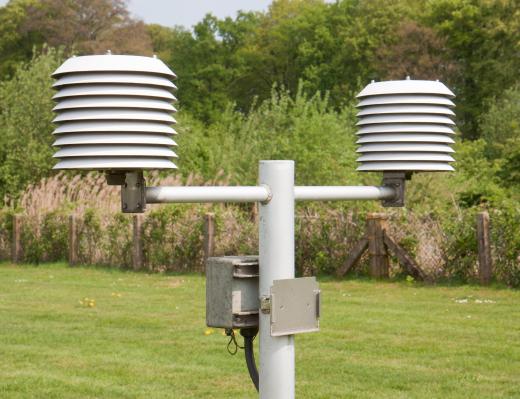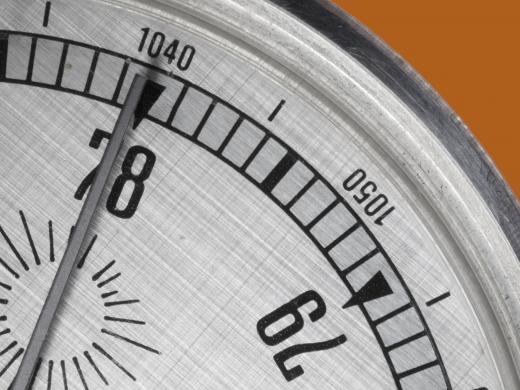In Meteorology, what is Station Pressure?
 Jessica Ellis
Jessica Ellis
"Station pressure" is a term used in meteorology that describes the air pressure at the location of reporting. In effect, it measures the relationship between the weight of the air that extends in a column directly above the area of measurement, and the size of the area being measured. Air pressure measurements depend on the altitude and air temperature at the station, so widely different pressure readings can be given at the same time depending on where the station is located.
Though it cannot be seen or held, the air that makes up Earth's atmosphere is very heavy. The weight of this air exerts pressure on the Earth's surface, which is what is truly being measured to get an air pressure reading. To measure this pressure, an instrument known as a barometer is used. Most barometers use either liquid, mercury, or an accordion-like metal structure to contract as pressure increases and expand as it decreases. The measurement read directly from a barometer is known as station pressure.

Station pressure can vary based on the altitude of the station. Since pressure measures the weight of the air in a column above the station, the higher the station, the shorter the column of air. A station that is several thousand feet up a mountain will generally have much lower pressure readings than one at sea level, simply because there is less air above it.

Temperature is another factor that can affect station pressure readings. As temperature drops, air becomes sluggish and more dense, making the weight of the air increase. When the weight increases, the pressure also goes up, causing a higher station pressure reading. Air pressure is also usually higher over the sea than on land, since water is heated more slowly than land, thus keeping the surface temperature generally lower. It is important to note that these relationships are often complicated by factors such as winds and the Earth's rotation, however, and are usually more complex than the basic concept of station pressure would indicate.

Weather also plays a major part in shifting air pressure; thermometer and barometer readings are frequently used to predict weather patterns. A significant barometer drop usually indicates that the air mixture is being intruded upon by lighter water vapors, which are associated with storms, hurricanes, and tornadoes. If a station pressure drops suddenly, it can indicate a storm on the horizon. Sudden rises, conversely, indicate dry weather or icy frosts.
Station pressure numbers are usually reported either in inches (or centimeters) of mercury or hectopascals. This measurement refers to how far the level of mercury is pushed on a liquid-based barometer. Hectopascals, which are also sometimes called millibars, give a more direct reading of the air pressure.
AS FEATURED ON:
AS FEATURED ON:













Discuss this Article
Post your comments